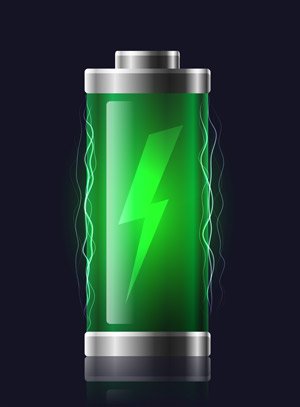I won a science fair at age 12 by making a "perpetual motion" machine. It really didn't do very much, but was kind of cool.
It used ions in a closed container, running them through a charged screen between magnets. Since the charge was constantly changing, the ions repeatedly moved between the magnets.
By putting a simple drive shaft mechanism through the center, I could light a (very) low-wattage bulb... or at least make it flicker.
In fact, I called it a "flicker tickler." OK, remember, I was only 12.
Last week, my experiment was brought back to mind by the release of an intriguing report.
We may be looking at a huge advance in energy technology here, with massive implications for your energy holdings.
See, the continued improvements in renewable energy sources like solar and wind have ushered in a serious conversation about what the energy balance will look like in the future.
As I've said, this isn't about any one "silver bullet" that will replace all energy sources. It's not even about the death of hydrocarbons.
It's about a single technology that will make energy sources - wind, solar, oil, gas, etc. - interchangeable...
[mmpazkzone name="in-story" network="9794" site="307044" id="137008" type="4"]
The New Energy Balance Needs Better Power Storage
There will be a need for all energy sources, based on each one's individual strengths and weaknesses - and as seamless a system as possible to move from one to the other.
 Because the most efficient and secure energy environment is one that provides a range of genuinely different sources.
Because the most efficient and secure energy environment is one that provides a range of genuinely different sources.
Yet, this balance requires a wider range of alternative energy sources, and those need to be available when needed and interchangeable.
For example, take oil or natural gas. They can be held physically until used.
Solar and wind, meanwhile, cannot.
"Universal Fuel": This could power the planet for 36,000 years. They spent $400 million to kill it. Click here for the story...
Now, the latter two are quickly reaching grid parity with other generating sources. That is, the costs of producing electricity are now about the same.
The difficulty arises from the intermittent nature of the power produced. The sun isn't shining continuously, and the wind doesn't blow all the time.
This prevents solar and wind power from being widely (and seamlessly) connected to a national power grid.
Overcoming this issue requires energy storage systems, giving rise to two major problems.
The first addresses cost and applicability.
Currently used storage systems run at $100 per kilowatt-hour (kWh) or more and cannot be connected in many locations.
That's very expensive, adding a large percentage to the total cost of solar or wind power.
It's hardly a stretch to say that a breakthrough here - in terms of battery price and efficiency - remains the "Holy Grail" of the energy sector.
The second problem is the simple fact that there has been no effective battery system on the horizon to overcome these shortcomings.
That is, until now...
MIT Just Had a Battery Breakthrough
Last week, researchers at the Massachusetts Institute of Technology (MIT) reported progress on what may be a huge step in that direction.
On Oct. 11, MIT-based (and U.S. Department of Energy-funded) researchers reported that they have developed an "air-breathing" battery capable of storing electricity for long periods of time, at about $20 a kWh.
MIT's news release, meanwhile, puts it this way:
"For its anode, the rechargeable flow battery uses cheap, abundant sulfur dissolved in water. An aerated liquid salt solution in the cathode continuously takes in and releases oxygen that balances charge as ions shuttle between the electrodes. Oxygen flowing into the cathode causes the anode to discharge electrons to an external circuit. Oxygen flowing out sends electrons back to the anode, recharging the battery."
All this sounds strangely familiar to the 12-year-old lurking somewhere in my memory.
One principal of the MIT project put it this way: "This battery literally inhales and exhales air, but it doesn't exhale carbon dioxide, like humans - it exhales oxygen."
Here's what that means...
This Technology Is Dirt-Cheap and Very Efficient
According to the researchers, a major issue with batteries has been the need to synthesize materials to increase the energy density of batteries (how much power you can store in a battery of a given size).
 We can do it, but the materials required are inordinately expensive.
We can do it, but the materials required are inordinately expensive.
That's where this air-breathing battery comes in.
By relying on sulfur and air, it's dirt cheap.
The total chemical cost of this system is about 3% that of a lithium battery, but it can store electricity for prolonged periods of time for a fraction of the cost now required by less efficient systems.
It's a "flow battery," where electrolytes are continuously pumped through electrodes and travel through a reaction cell to create charge or discharge.
Only this time, unlike with my winning experiment from when I was 12, the power contained in the system can light more than one light bulb.
Actually, it can light a lot of them.
And because the battery uses ultra-low-cost materials, its chemical cost is one of the lowest - if not the lowest - of any rechargeable battery to enable cost-effective, long-duration discharge.
Its energy density is slightly lower than today's lithium-ion batteries, however, meaning that it takes up slightly more space per unit of energy.
While lithium-sulfur and lithium-air batteries exist today, the key innovation of the MIT research is combining the two to create a lower-cost battery with comparable efficiency and energy density.
Here's the other neat consideration: Flow batteries are highly scalable, providing the ability to structure much larger systems than the current prototype (about the size of a coffee cup).
And here is where the connection to renewable sources - and renewable power companies - comes into play: As the battery can discharge over months, it would be an excellent way for storing electricity from unpredictable sources like solar and wind.
Investors who hold the companies I recommended in "Two Easy Ways to Play Energy's Fastest-Growing Sector" stand to make even more money if this technology develops the way I think it should.
(You can click here to get those two energy recommendations, by the way, along with all of my free Oil & Energy Investor research.)
Now, if only I had patented my little "flicker tickler..."
Utility Companies Spent $400 Million to Kill This
It can power your car, heat your home, and even run entire factories. This special fuel is "harvested" in most parts of the world, and there's enough to power the planet for 36,000 years. Yet D.C. lobbyists made $400 million preventing it from going mainstream. See why tech companies are investing millions in this fuel (and how to join them). Click here to continue.
Follow Kent on Facebook and Twitter.
About the Author
Dr. Kent Moors is an internationally recognized expert in oil and natural gas policy, risk assessment, and emerging market economic development. He serves as an advisor to many U.S. governors and foreign governments. Kent details his latest global travels in his free Oil & Energy Investor e-letter. He makes specific investment recommendations in his newsletter, the Energy Advantage. For more active investors, he issues shorter-term trades in his Energy Inner Circle.



